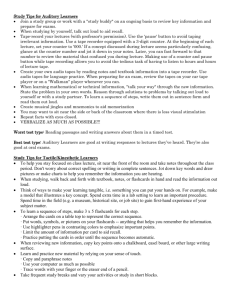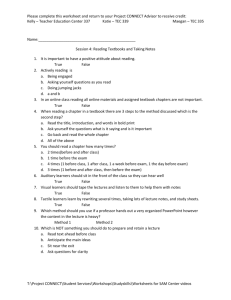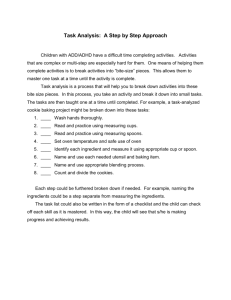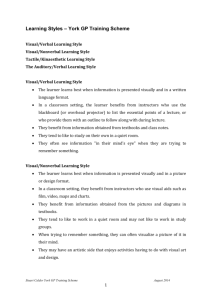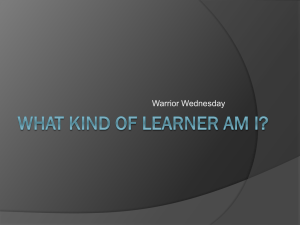Study Skills by learning style
advertisement
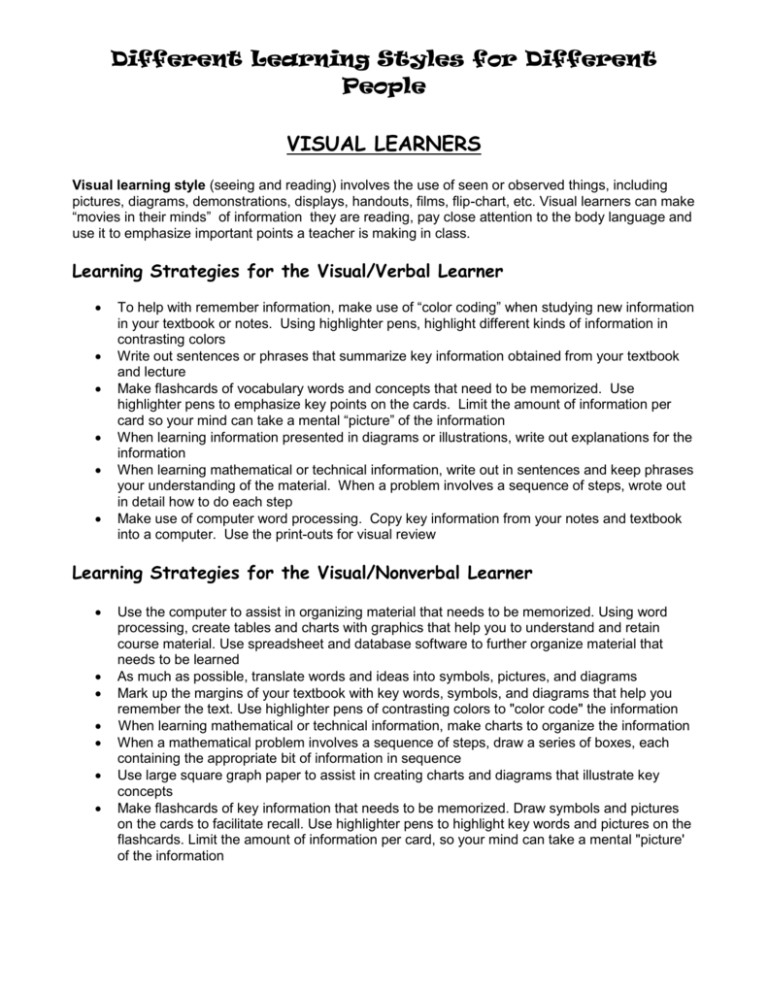
Different Learning Styles for Different People VISUAL LEARNERS Visual learning style (seeing and reading) involves the use of seen or observed things, including pictures, diagrams, demonstrations, displays, handouts, films, flip-chart, etc. Visual learners can make “movies in their minds” of information they are reading, pay close attention to the body language and use it to emphasize important points a teacher is making in class. Learning Strategies for the Visual/Verbal Learner To help with remember information, make use of “color coding” when studying new information in your textbook or notes. Using highlighter pens, highlight different kinds of information in contrasting colors Write out sentences or phrases that summarize key information obtained from your textbook and lecture Make flashcards of vocabulary words and concepts that need to be memorized. Use highlighter pens to emphasize key points on the cards. Limit the amount of information per card so your mind can take a mental “picture” of the information When learning information presented in diagrams or illustrations, write out explanations for the information When learning mathematical or technical information, write out in sentences and keep phrases your understanding of the material. When a problem involves a sequence of steps, wrote out in detail how to do each step Make use of computer word processing. Copy key information from your notes and textbook into a computer. Use the print-outs for visual review Learning Strategies for the Visual/Nonverbal Learner Use the computer to assist in organizing material that needs to be memorized. Using word processing, create tables and charts with graphics that help you to understand and retain course material. Use spreadsheet and database software to further organize material that needs to be learned As much as possible, translate words and ideas into symbols, pictures, and diagrams Mark up the margins of your textbook with key words, symbols, and diagrams that help you remember the text. Use highlighter pens of contrasting colors to "color code" the information When learning mathematical or technical information, make charts to organize the information When a mathematical problem involves a sequence of steps, draw a series of boxes, each containing the appropriate bit of information in sequence Use large square graph paper to assist in creating charts and diagrams that illustrate key concepts Make flashcards of key information that needs to be memorized. Draw symbols and pictures on the cards to facilitate recall. Use highlighter pens to highlight key words and pictures on the flashcards. Limit the amount of information per card, so your mind can take a mental "picture' of the information AUDITORY LEARNERS Auditory learning style (listening and speaking) involves the transfer of information through listening: to the spoken word, of self or others, of sounds and noises. Auditory learners tend not to take notes from lectures because they can remember quite accurately details of information they hear during conversations and lectures. Auditory learners tend to have strong oral communication skills and are good at giving speeches, oral reports and expressing their ideas. Strategies for the Auditory/Verbal Learner Make flashcards of key information that needs to be memorized. Draw symbols and pictures on the cards to facilitate recall. Use highlighter pens to highlight key words and pictures on the flashcards. Limit the amount of information per card, so your mind can take a mental "picture' of the information When studying by yourself, talk out loud to aid recall. Get yourself in a room where you won't be bothering anyone and read your notes and textbook out loud Tape record your lectures. Use the 'pause' button to avoid taping irrelevant information. Use a tape recorder equipped with a 3-digit counter. At the beginning of each lecture, set your counter to '000.' If a concept discussed during lecture seems particularly confusing, glance at the counter number and jot it down in your notes. Later, you can fast forward to that number to review the material that confused you during lecture. Making use of a counter and pause button while tape recording allows you to avoid the tedious task of having to listen to hours and hours of lecture tape Use books on tape to aid recall. Or, create your own audio tapes by reading notes and textbook information into a tape recorder. When preparing for an exam, review the tapes on your car tape player or on a "Walkman" player whenever you can When learning mathematical or technical information, "talk your way" through the new information. State the problem in your own words. Reason through solutions to problems by talking out loud to yourself or with a study partner. To learn a sequence of steps, write them out in sentence form and read them out loud. KINISTHETIC LEARNERS Kinesthetic learning style (touching and doing) involves physical experience- touching, feeling, holding, doing, and practical hands-on experiences. Kinesthetic learners need information broken into steps; Step 1, Step 2, Step 3, etc. and tend to remember dates, math equations and scientific information well if it presented in a sequential (in order) manner. Strategies for the Kinesthetic Learner To help you stay focused on class lecture, sit near the front of the room and take notes throughout the class period. Don't worry about correct spelling or writing in complete sentences. Jot down key words and draw pictures or make charts to help you remember the information you are hearing When studying, walk back and forth with textbook, notes, or flashcards in hand and read the information out loud Think of ways to make your learning tangible, i.e. something you can put your hands on. For example, make a model that illustrates a key concept. Spend extra time in a lab setting to learn an important procedure. Spend time in the field (e.g. a museum, historical site, or job site) to gain first-hand experience of your subject matter To learn a sequence of steps, make 3'x 5' flashcards for each step. Arrange the cards on a table top to represent the correct sequence. Put words, symbols, or pictures on your flashcards -- anything that helps you remember the information. Use highlighter pens in contrasting colors to emphasize important points. Limit the amount of information per card to aid recall. Practice putting the cards in order until the sequence becomes automatic When reviewing new information, copy key points onto a chalkboard, easel board, or other large writing surface Make use of the computer to reinforce learning through the sense of touch. Using word processing software, copy essential information from your notes and textbook. Use graphics, tables, and spreadsheets to further organize material that must be learned Listen to audio tapes on a Walkman tape player while exercising. Make your own tapes containing important course information.
